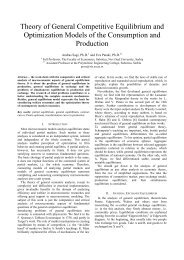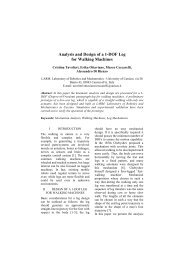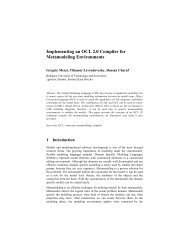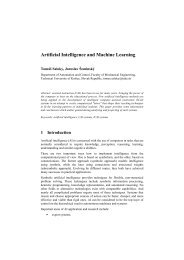flow of the software, it is possible to implement it into themodel of the presented method for concurrency.V. CONCLUSIONConcurrent programming is complex and hard toachieve. In most cases the parallelization of software isnot a straightforward and easy task. The realizedconcurrent programs usually have safety and performanceissues. For embedded systems the existing parallelizationalgorithms and solutions are not optimal due to resourcerequirements and safety issues. The goal is to realize sucha solution for concurrent programming, which is optimalfor embedded systems and helps and simplifies thedevelopment of concurrent programs. The key tosuccessful development of parallel programs is in therealization of tools which take into consideration thehuman factors and aspects of parallel development.The model presented in this paper builds on theadvantages of existing parallelization algorithms withhuman factor as its primary deciding factor. In thedevelopment of a concurrent applications, the usedparallelization algorithms and solutions are important, butthe most important factor is the developer/user itself. Toachieve the best possible results, to achieve efficientsoftware, we must concentrate on the most importantfactor of development, the human (developer).The presented parallelization model is best applicable ifthe problem we would like to solve is not triviallyparallelizable, which is true for the great number ofalgorithms and software.REFERENCES[1] Tim Harris, Simon Marlow, Simon Peyton Jones, MauriceHerlihy, “Composable memory transactions,” Proceedings of thetenth ACM SIGPLAN symposium on Principles and practice ofparallel programming, pp. 48–60, 2005.[2] Anthony Discolo, Tim Harris, Simon Marlow, Simon PeytonJones, Satnam Singh, “Lock -Free Data Structures using STMs inHaskell,” Functional and Logic <strong>Program</strong>ming,pp.65–80, 2006.[3] Tim Harris and Simon Peyton Jones, “Transactional memory withdata invariants,” ACM SIGPLAN Workshop on TransactionalComputing, 2006.[4] Paul Baran, “On Distributed Communications Networks,” IEEETransactions on Communications Systems, vol. 12, issue 1., pp 1-9, 1964.[5] César Sanchez, “Deadlock Avoidance for Distributed Real-Timeand Embedded”, Dissertation, Department of Computer Science ofStanford University, 2007 May.[6] Y. Yorozu, M. Hirano, K. Oka, and Y. Tagawa, “MTIO. Amultithreaded parallel I/O system,” Parallel ProcessingSymposium,. Proceedings, 11th International, pp. 368-373, 1997.[7] Girija J. Narlikar, Guy E. Blelloch, “Space-efficient scheduling ofnested parallelism,” ACM Transactions on <strong>Program</strong>mingLanguages and Systems, pp. 138-173, 1999.[8] Girija J. Narlikar, Guy E. Blelloch, “Space-efficientimplementation of nested parallelism,” Proceedings of the SixthACM SIGPLAN Symposium on Principles and Practice ofParallel <strong>Program</strong>ming, 1997.[9] Bondavalli, A.; Simoncini, L., “Functional paradigm for designingdependable large-scale parallel computing systems,” AutonomousDecentralized Systems, 1993. Proceedings. ISADS 93,International Symposium on Volume, Issue, 1993, pp. 108 – 114.[10] Jeffrey Dean and Sanjay Ghemawat, “MapReduce: SimplifiedData Processing on Large Clusters,” OSDI'04: Sixth Symposiumon Operating System Design and Implementation, 2004.[11] Gene Amdahl, “Validity of the Single Processor Approach toAchieving Large-Scale Computing Capabilities,” AFIPSConference Proceedings, (30), pp. 483-485, 1967.[12] Rodgers, David P., “Improvements in multiprocessor systemdesign,” ACM SIGARCH Computer Architecture News archiveVolume 13, Issue 3, pp. 225-231, 1985134
Renewable energy sources in automobilityZoltán J. Pék MScME * , Jozsef M. Nyers Dr. Sci *** Technical School Ivan Sarić/Mechanical Department, Subotica, Serbia** Subotica Tech. Serbia , University Obuda Budapest, Hungarye-mail: pekzoli@tippnet.rse-mail : jnyers@vts.su.ac.rsAbstract—This article gives a instruction into the basicguidelines for preparing an automobile for application ofthe renewable energy sources. The energy source is asunlight uses the photovoltaic elements. In paper describethe history and materials of photovoltaic elements.Index Terms – renewable energy sources, solar power, solarenergy, electromobil, photon energy, electrical, photovoltaicelements, materials, solar cell efficiency.I. INTRODUCTIONA solar cell (also called photovoltaic cell orphotoelectric cell) is a solid state electrical device thatconverts the energy of light directly into electricity by thephotovoltaic effect. What powers the electric motor andsolar energy?The idea that the drive uses a motor vehicle is not new.A charge of electric current through the battery, we get byusing solar cells, the question is quite recent past, presentand especially future. Large electric motors started back inthe early nineties 20th century, unfortunately withoutmuch success. The electric motor is most efficient in citydriving, where over 90% of the mileage driven at lowspeeds. Some of the first cars ever built were powered byelectricity. These first-fueled cars electric appeared asearly as the late 19th century (actually 1880), a step whichthe vehicle is driven on gasoline are held until the early20th century, when oil was due to the increasingexploitation has become significantly cheaper and hasdeveloped infrastructure for its distribution. Today is thetime that this technology back in a big way, because itoffers many advantages, especially when it comes toecology. In addition to ecology, electric range offers evenmore advantages as a fuel for vehicles. This is its excellentmechanical simplicity, eliminating the need for a complexcurrency exchange and transmission assembly makes thiscar extremely reliable. The electric motor has theadvantage of being reversible, except that the energytransferred into kinetic energy, is able to transform kineticenergy into electricity to supplement the battery. Modernelectric motors are much more advanced today were thedirect switch to AC power, and electronic engine controlwas significantly improved, and from these aggregates canbe drawn significantly better performance withoutincreasing in size. Before the mass introduction of electricmotor drives for passenger cars must be resolved someissues and concerns mainly energy driven by the electricmotor. Current technology offers a couple of complete andseveral intermediate solutions that work in practice. Thecomplete solution is still in development phase. Here itcomes to batteries and fuel cells, while the transitionalarrangements, or hybrids, largely in the sale and areavailable to customers. When charging the battery andfuel cell applications of solar energy has its own solutions,although the pilot testing phase.A. History of solar cellsThe term "photovoltaic" comes from the Greek φῶς(phōs) meaning "light", and "voltaic", from the name ofthe Italian physicist Volta, after whom a unit of electromotiveforce, the volt, is named. The term "photo-voltaic"has been in use in English since 1849.[1]The photovoltaic effect was first recognized in 1839 byFrench physicist A. E. Becquerel. However, it was notuntil 1883 that the first photovoltaic cell was built, byCharles Fritts, who coated the semiconductor seleniumwith an extremely thin layer of gold to form the junctions.The device was only around 1% efficient. In 1888 Russianphysicist Aleksandr Stoletov built the first photoelectriccell based on the outer photoelectric effect discovered byHeinrich Hertz earlier in 1887.Albert Einstein explained the photoelectric effect in1905 for which he received the Nobel prize in Physics in1921.[2] Russell Ohl patented the modern junctionsemiconductor solar cell in 1946, [3] which wasdiscovered while working on the series of advances thatwould lead to the transistor.B. Solar energyAssemblies of solar cells are used to make solarmodules which are used to capture energy from sunlight.When multiple modules are assembled together (such asprior to installation on a pole-mounted tracker system), theresulting integrated group of modules all oriented in oneplane is referred to in the solar industry as a solar panel.The general public and some casual writers often refer tosolar modules incorrectly as solar panels; technically thisis not the correct usage of terminology. Nevertheless, bothdesignations are seen in regular use, in reference to whatare actually solar modules. The distinction between amodule and a panel is that a module cannot bedisassembled into smaller re-usable components in thefield, whereas a solar panel is assembled from, and can bedisassembled back into, a stack of solar modules. Theelectrical energy generated from solar modules, referred toas solar power, is an example of solar energy.C. PhotovoltaicPhotovoltaics is the field of technology and researchrelated to the practical application of photovoltaic cells inproducing electricity from light, though it is often usedspecifically to refer to the generation of electricity fromsunlight.Cells are described as photovoltaic cells when the lightsource is not necessarily sunlight. These are used fordetecting light or other electromagnetic radiation near thevisible range, for example infrared detectors, ormeasurement of light intensity.135
- Page 1 and 2:
4 4 th IEEE International Symposium
- Page 3 and 4:
EXPRES 20124 th International Sympo
- Page 5 and 6:
Application of Thermopile Technolog
- Page 7 and 8:
Design of a Solar Hybrid System....
- Page 9 and 10:
___________________________________
- Page 11 and 12:
environmental protection and global
- Page 13 and 14:
But can we use the human body sweat
- Page 15 and 16:
IX. REFERENCES[1] Todorovic B. Cvje
- Page 17 and 18:
QQ⎛ Λt⎞=⎜⎟⎝ Λ ⎠Nt Nwh
- Page 19 and 20:
Analysis of the Energy-Optimum of H
- Page 21 and 22:
V. OBJECTIVE FUNCTIONThe objective
- Page 23 and 24:
The Set-Up Geometry of Sun Collecto
- Page 25 and 26:
continuous east-west sun collector
- Page 27 and 28:
continuously measure the thermal ch
- Page 29 and 30:
CEvaluation of measurement resultsA
- Page 31 and 32:
Application of Thermopile Technolog
- Page 33 and 34:
Temperature of the components [C]90
- Page 35 and 36:
nighttime, to weather or to the cha
- Page 37 and 38:
η uη u0.50.40.30.20.1T 1 - 400K0.
- Page 39 and 40:
Figure 10. . SPS Concept illustrati
- Page 41 and 42:
[16] Zoya B. Popović: Wireless Pow
- Page 43 and 44:
25.0020.0015.0010.005.000.00Figure
- Page 45 and 46:
· ℃ 0.0738 · 1.209 0.0892
- Page 47 and 48:
use may be advantageous not only in
- Page 49 and 50:
To find the reasons for this disagr
- Page 51 and 52:
Toward Future: Positive Net-Energy
- Page 53 and 54:
EnergyPlus environment, we used mod
- Page 55 and 56:
To keep future energy consumption d
- Page 57 and 58:
A New Calculation Method to Analyse
- Page 59 and 60:
On Fig. 3. can be seen the areas th
- Page 61 and 62:
Present and Future of Geothermal En
- Page 63 and 64:
TABLE II.THE TEMPERATURE DATA AND C
- Page 65 and 66:
Error in Water Meter Measuring at W
- Page 67 and 68:
III.RESULTS OF MEASURMENTSEach meas
- Page 69 and 70:
TABLE I.THE AVERAGE VALUE OF THERMA
- Page 71 and 72:
If the walls of the DHEs are made o
- Page 73 and 74:
Environmental External Costs Associ
- Page 75 and 76:
iodiesel production facility with a
- Page 77 and 78:
Contribution of unit processesto ex
- Page 79 and 80:
Heat Pump News in HungaryBéla Ád
- Page 81 and 82:
Thermal Comfort Measurements In Lar
- Page 83 and 84:
IV.DISCUSSIONThe sample frequencies
- Page 85 and 86: For a Clear View of Traditional and
- Page 87 and 88: esults in geographically distribute
- Page 89 and 90: Design of a Solar Hybrid SystemMari
- Page 91 and 92: Maintaining the set point temperatu
- Page 93 and 94: Decision system theory model of ope
- Page 95 and 96: parameter of pump in the function o
- Page 97 and 98: Importance and Value of Predictive
- Page 99 and 100: D. Overview of existing boiler oper
- Page 101 and 102: HEAVY FUEL OIL FIRED, STEAMNATURAL
- Page 103 and 104: MATHEMATICAL MODEL AND NUMERICAL SI
- Page 105 and 106: C. Energy balance equationMathemati
- Page 107 and 108: Discretization energy balance equat
- Page 109 and 110: T ulf=32 º C, A - m =0.00162 kg/s,
- Page 111 and 112: Comparison of Heat Pump and MicroCH
- Page 113 and 114: the microCHP development. The energ
- Page 115 and 116: control and stabilizer must be deve
- Page 117 and 118: In Figure 1, in relation to the ord
- Page 119 and 120: NPCC BHXOBYNI x1I x2I x3I x4LO YKYO
- Page 121 and 122: exchange, as in reality, economies
- Page 123 and 124: esponsibilities for consequences, o
- Page 125 and 126: Coca-Cola Enterprise Inc had approx
- Page 127 and 128: Flow Pattern Map for In Tube Evapor
- Page 129 and 130: circumference with a liquid film. T
- Page 131 and 132: Tube diameter: d 6 mm W Heat flux
- Page 133 and 134: Realization of Concurrent Programmi
- Page 135: applications the development, optim
- Page 139 and 140: commercial arrays can be built at b
- Page 141 and 142: of multiple thin films produced usi
- Page 143: EXPRES 20124 th International Sympo












